
by successfulbob | Guest Post, photography, travel photography
Travel in China – Xi’an – Part Three
Guest Post – Ken MacAdams
See the previous posts from Ken on Xi’an, China. Part One and Part Two
“Discovered in 1974 by a peasant digging a well, the tomb area covers about 22 square miles. The main part of the emperor’s tomb has yet to be excavated, but three pits have been discovered and excavation work continues to this day. Some estimate that there are over 8,000 clay warriors at the site. These pottery figures of soldiers, horses and chariots leave no doubt that the emperor wanted a bodyguard in the afterlife. Pit 1 alone has yielded over 6,000 soldiers, plus horsemen and chariots. These soldiers are slightly larger than life size, and each is different from the others. The soldiers wear a variety of uniforms and body armor, different hair styles, and some sport mustaches. Some are kneeling – indicating they were archers holding now-decayed wooden bows or cross-bows, while others would have held swords or pikes. The figures are a fascinating link to a society 22 centuries ago.
 This is the Bell Tower with contrasting modern buildings in the background.
This is the Bell Tower with contrasting modern buildings in the background.
During the daytime you can enter both the Bell and Drum Towers. A few dynasties – and centuries – later, the Ming dynasty erected one of the most famous and best examples of ancient city walls. Construction of the still standing present day wall began on the remains of the old Sui and Tang dynasty walls. Encompassing the old city, the square shaped Ming Wall is 8.5 miles in circumference, 40 ft. tall, and about 45 ft. wide on top. It was purposely built wide enough that two chariots could pass by each other with ease. A moat surrounds the wall, and there were four gates into the city, one on the North, East, South, and West sides. The South Gate is the best preserved example with it’s massive archers tower still intact, along with the drawbridge. Xi’an’s Old City Wall is the only ancient wall in China to have survived the Cultural Revolution in its entirety.
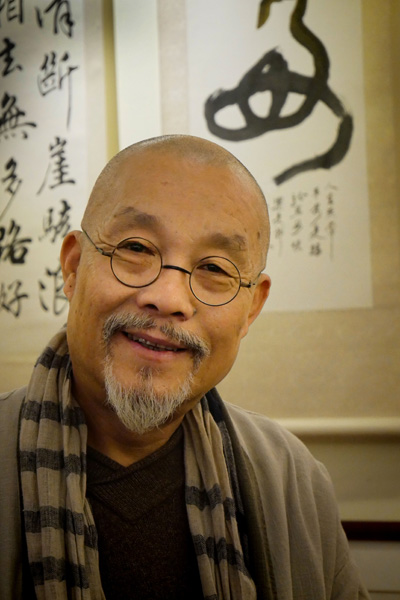 This is an artist in the Art Gallery District who invited us in to join him for a tea ceremony. After visiting, he painted a calligraphy spread, and insisted we take it as a gift! Some of his work is hanging in the background.
This is an artist in the Art Gallery District who invited us in to join him for a tea ceremony. After visiting, he painted a calligraphy spread, and insisted we take it as a gift! Some of his work is hanging in the background.Each Ming city had a bell and drum tower. The bell was sounded at dawn, and drum at dusk. The original bell no longer exists, but a replica stands on the corner of the tower. The bell and drum signaled the opening and closing the city gates. Several cities still have their bell and drum towers, but Xi’an’s is the most widely known of all of them. The Bell Tower was built in 1384 AD and the Drum Tower built four years earlier, in 1380. Today, both towers, and all wall buildings are outlined in colorful LED lights that come on at dusk. The lighting is tastefully done, and adds a special magic to the night air of Old Town Xi’an!
A few blocks away is Xi’an’s Muslim community. Within is the Great Mosque, surrounded by old houses and narrow streets. The Great Mosque survived the Cultural Revolution and remains as an Islamic place of worship. It was founded in AD 742, and the present layout dates from the 14th century.
About 146 BC, during the Han dynasty, Emperor Han Wudi launched a series of military campaigns against the warlike Turkish people to the Northwest. Merchant caravans followed the armies, and established routes that the Europeans later called the Silk Road. Originating in Xi’an, these routes formed links of trade and cultural exchange to the West. Paper, gunpowder, (both Chinese inventions), spices, silk, jade, and many other goods were carried by merchant caravans to the West.
The first contacts between adherents of Buddhism and the Chinese were made by the opening of the Silk Road. (It was via this same link that the Muslim faith came into China.) During the Tang dynasty, Xi’an became the main center for Buddhist learning in Asia. A number of monuments bear witness to the importance of Buddhism in the city’s history. Two prominent landmarks still standing today are the Big and Little Goose Pagodas. Numerous Chinese monks, scholars and translators are recorded having made the journey to India in search of enlightenment. It was at the Little Goose Pagoda where monks spent 20 years translating and converting the Indian language documents into Chinese. The Big Goose Pagoda may have been at tall as 12 stories, but either fire or an earthquake (historical documents vary) damaged the original structure, and it was reduced to 7 stories, as it stands today. You can climb 288 steps inside to the top of the pagoda. On a clear day, your efforts will reward you great views of the surrounding city.
Today, Xi’an continues to grow. By 1954 the city outgrew the Old City walls, and began to spread. The population today stands at about 11 million, of which I’m told 1 million are university students. Pharmaceuticals, electronics, and auto parts are among the industries here, and agriculture plays a significant role in the surrounding area.
In a culture significantly different from ours, I’ve made multiple friends and acquaintances that welcome me back year after year. Each visit I find new subjects to train my lens on, or in some cases, explore a new angle to shoot from. This land is intriguing, charming, and wonderful to experience up close and personal. It’s also a land that’s changing – and changing fast! I’m glad to be documenting some of the ancient along with that change.”
Ken has always loved to travel, so when he made a common connection with the fact that either a long day pounding the streets of some foreign city, or shooting the last dance at a wedding, a good part of his physical

weariness came from lugging around his big heavy DSLR. That’s when he started looking at alternatives – and ended up selecting Panasonic Lumix Micro Four Thirds gear.
Ken is rarely without a camera, and the next great photo travel experience – whether local or abroad – is always in the back of his mind! A longtime resident of the Four Corners, and when he’s not out on the road, he enjoys some of the great outdoor opportunities found there – mountain biking, hiking, and Jeeping.
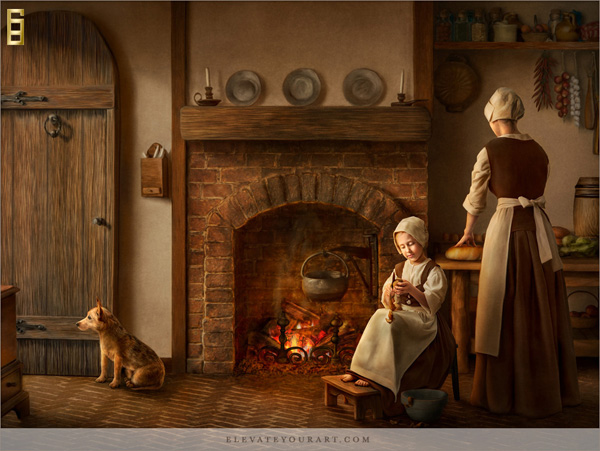
by successfulbob | fine art photography, fine art portrait, imaging competition, photography, tuesday painterly photo art
Tuesday Painterly Art – Part Two
Michelle Parsley – M.Photog, M. Artist, Cr., CPP
I had the pleasure of taking a Michelle Parsley full day Pre-Con class at Imaging USA this year. I was extremely impressed with her attention to detail and classroom style. If you ever get the opportunity to learn from Michelle, I highly recommend it. BTW you can also work with Michelle online. Check out links to her education at the bottom ot the post.
Hear again from Michelle as she continues her talk about her work and producing images for PPA’s International Photographic Competition
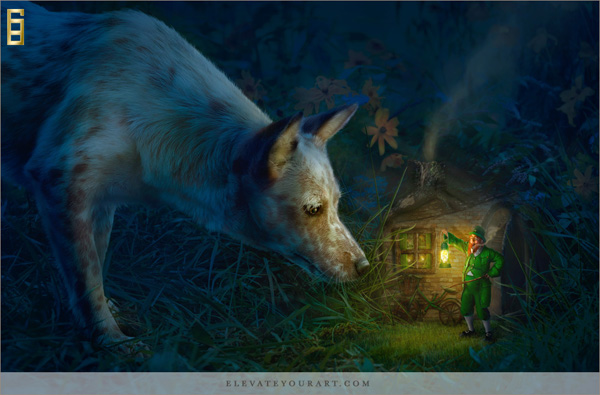
“Another glimpse into my imagination would be “Get off my lawn!”. Who hasn’t thought of
finding a Leprechaun? Just me?? Oh, ok… ;)
I absolutely love history. You can see the influence of times gone by in images like, “Secret
Admirer”, “Patchwork”, “Waiting for Papa”, and “All in a Day’s Work”. These were some of my
favorite images I’ve ever created — partly because of the historical context, but also because I
built the “sets” in scale miniature and composited my subjects into the scenes. None of those
rooms are more than 12 inches tall!
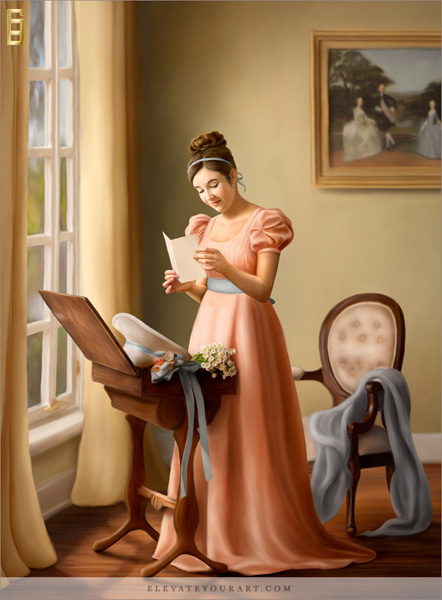 “Secret Admirer”
“Secret Admirer”
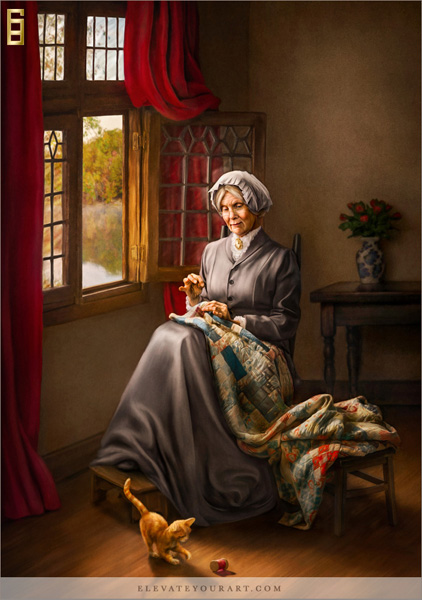 “Patchwork”
“Patchwork”
 “Waiting for Papa”
“Waiting for Papa”

“Source of Wisdom”
Easily one of the craziest things I have ever done for print competition was “The Source of
Wisdom”. This print really has to be seen in person to appreciate it. I knew by adding 3D
elements to the print, I was risking being disqualified — but it was something I just had to try. I
have an absurd amount of time in both building the set (I made over 300 books the size of my
thumbnail!!), compositing over 50 frames together, and then adding the miniature books to the
face of the print to give the final piece a 3D feel. At one point I found myself VACUUMING the
print to be 100% sure none of my elements would damage anyone else’s entry. Thankfully –
the judging panel really understood the story and rewarded me with a loan. One word of
caution — if you ever attempt a 3D print, ALL of the 3D elements must be below the face of the
mat or you could potentially be DQ’d for damaging other entries. Proceed with caution!”
Michelle Parsley, M.Photog, M. Artist, Cr., CPP
Behind every artist there is a story and Michelle’s story began as a child when she would draw or paint with anything she could find (which got her in trouble on more than one occasion!). She has been creating hand drawn and hand
painted art for clients for nearly 20 years. Michelle is mostly self-taught in all the mediums she uses to express
her creativity. By combining her love of both digital and organic mediums, Michelle is uniquely equipped to both create and teach art. Michelle earned her Certified Professional Photographer (CPP) designation from Professional
Photographers of America (PPA) in 2009 which led her to enter her first International
Photographic Competition in 2010.
She has since earned the Master of Photography 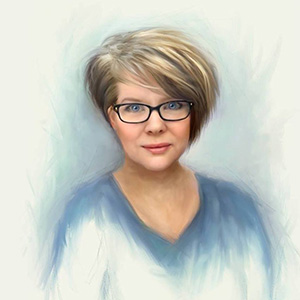
and Master Artist degrees in 2014, diamond artist of the year in 2012, the
Imaging Excellence Award in 2015, Photographic Craftsman in 2017, Double diamond and the Imaging Excellence Bar in 2018.
When Michelle is not teaching, photographing, or painting, she enjoys a great cup of coffee, dark chocolate, and working on the family farm in rural Tennessee where she lives with her husband of over 25 years, their four children, four dogs, and an ever changing host of farm animals.
The class I took from Michelle – Photoshop Clone Painting
More Clone Painting Classes – All Clone Painting Classes
General Teaching site – Elevate Your Art
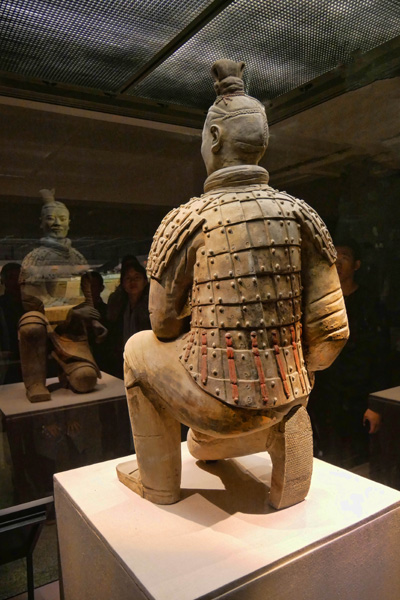
by successfulbob | Guest Post, landscape photography, Lumix G9, photography, travel photography
Travel in China – Xi’an – Part Two
Guest Post – Ken MacAdams
Ken’s continuing images and stories from Xi’an, China. See the last post here.
“For this blog edition, let me introduce you to some background of this interesting locale.
 This is Fengqing Park, one of the many beautiful parks within the city.
This is Fengqing Park, one of the many beautiful parks within the city.
It’s a quiet place where the locals come from dawn to dusk.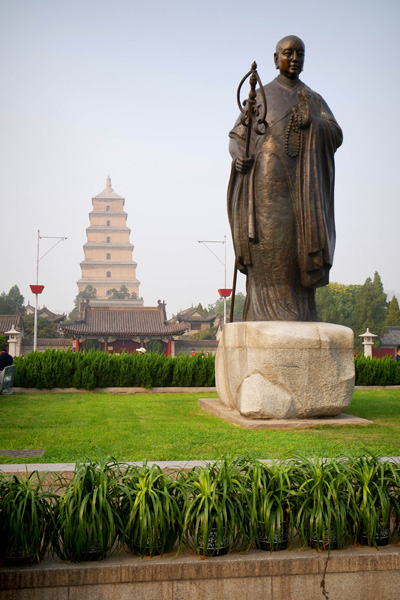 Wild Goose Pagoda with the statue of the monk credited with bringing Buddhism to China.
Wild Goose Pagoda with the statue of the monk credited with bringing Buddhism to China.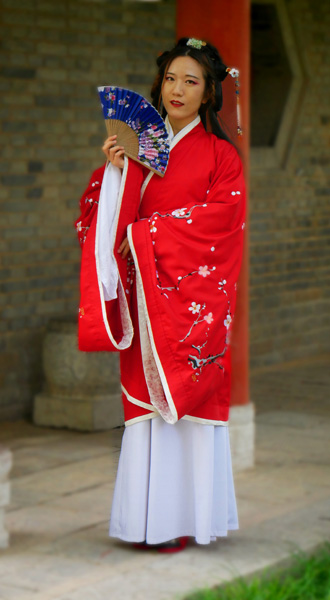 Woman dressed in Period costume at the Little Goose Pagoda.
Woman dressed in Period costume at the Little Goose Pagoda.In the history of China, Xi’an has played a large and significant role – one that stretches longer in time than perhaps any other city in China. It acted as the capital of China for over 1,100 years, and has never fallen out of importance. Archaeological and art discoveries in and around the city tell a tale of China’s development from prehistoric times until the height of the imperial period. Many tombs and sites remain un excavated to this day. Xi’an is geographically located in the center of present day China.
 Pit 1. This is the first pit that was discovered and where excavation began.
Pit 1. This is the first pit that was discovered and where excavation began.
It is estimated there are 6,000 soldiers buried here. Note the armor detail and remaining paint pigment. The sole of his shoe even has tread detail!
Note the armor detail and remaining paint pigment. The sole of his shoe even has tread detail!Xi’an lies on the Wei River in the Shaanxi Province, and served as capital at different times for the Zhou, Han, Sui, and Tang dynasties. The origins of Xi’an can be traced to the 11th century BC, when rulers of the Zhou dynasty founded a city about 10 miles from present day Xi’an. In 221 BC the King of Qin conquered the other feudal kingdoms in the region to become the First Emperor. During his rule, he extended various sections of the Great Wall to keep out the fierce northern tribesmen, but perhaps more notable was his standardization of the Chinese written language, coinage, and weights and measures. It was Qin who was responsible for another of the greatest wonders of the ancient world – his army of terracotta warriors.
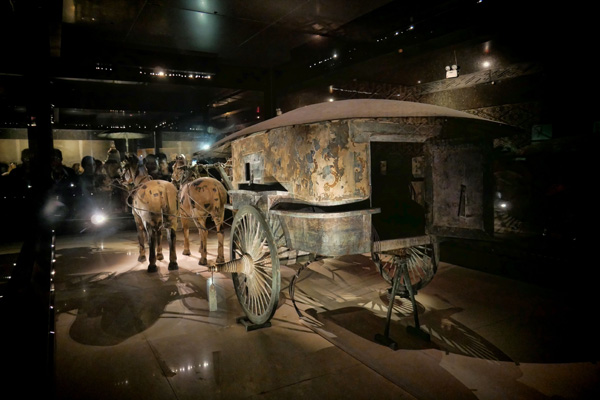 This is the bronze chariot for the Emperor. It weighs almost 2,000 lbs., and silk fabric was found inside.
This is the bronze chariot for the Emperor. It weighs almost 2,000 lbs., and silk fabric was found inside. More from Ken’s adventures next week!
Ken has always loved to travel, so when he made a common connection with the fact that either a long day pounding the streets of some foreign city, or shooting the last dance at a wedding, a good part of his physical

weariness came from lugging around his big heavy DSLR. That’s when he started looking at alternatives – and ended up selecting Panasonic Lumix Micro Four Thirds gear.
Ken is rarely without a camera, and the next great photo travel experience – whether local or abroad – is always in the back of his mind! A longtime resident of the Four Corners, and when he’s not out on the road, he enjoys some of the great outdoor opportunities found there – mountain biking, hiking, and Jeeping.
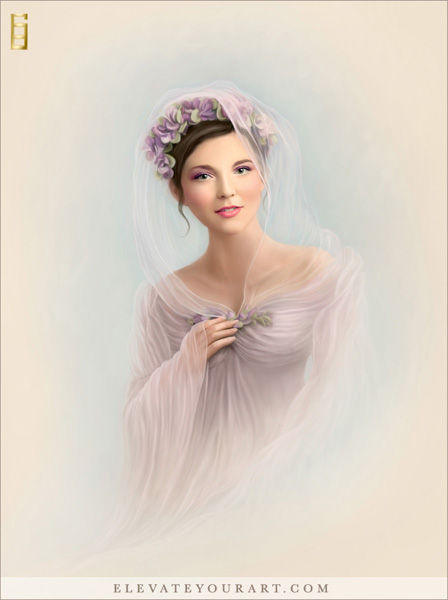
by successfulbob | painting study, photography, photography competition, photography creativity, tuesday painterly photo art
Tuesday Painterly Art
Michelle Parsley M.Photog, M. Artist, Cr., CPP
I had the pleasure of taking a Michelle Parsley full day Pre-Con class at Imaging USA this year. I was extremely impressed with her attention to detail and classroom style. If you ever get the opportunity to learn from Michelle, I highly recommend it. BTW, you can also work with Michelle online. Check out links to her education at the bottom of the post.
Hear now from Michelle below as she talks about her work and producing images for PPA’s International Photographic Competition. All Images © Michelle Parsley 2019 All Rights Reserved
 “For most of my client work, I create “pretty pictures” in either digital or traditional mediums. An
“For most of my client work, I create “pretty pictures” in either digital or traditional mediums. An
example of client work would be “A Study in Pastels”.
But when I’m given free rein to do anything I want — I love to tell stories with my images. I
believe storytelling is one of my artistic strengths and I find it especially satisfying when others
can easily see the story. I often employ this tactic in my competition images.
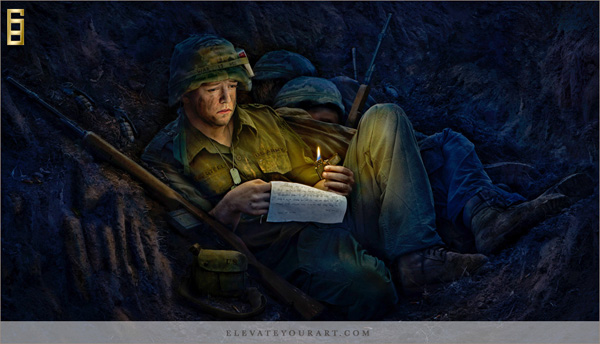 Sometimes, I am compelled to tell a serious story — like in the image “Dear John”. Anyone
Sometimes, I am compelled to tell a serious story — like in the image “Dear John”. Anyone
that has served in our armed forces can easily identify with this image.
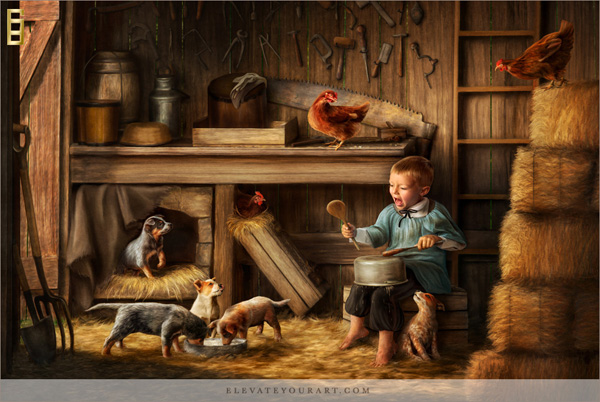 More often than not, I tell humorous stories like “Dinner and a Show”. What little one hasn’t
More often than not, I tell humorous stories like “Dinner and a Show”. What little one hasn’t
used a pot for a drum and sang at the top of their lungs? By giving him an audience of
puppies in a barn, it accurately reflects the realities of life with boys on the farm. (No — this
child is not one of my boys)
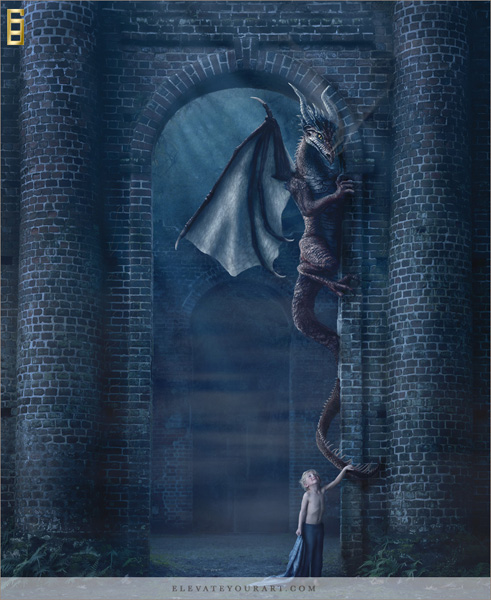 In “Who’s Training Whom?” You can really get a glimpse into my imagination. I had the
In “Who’s Training Whom?” You can really get a glimpse into my imagination. I had the
pleasure of visiting the old Sheldon Church ruins in the Charleston, SC area with Tiffany Briley
of Charleston Photography Tours a few years back. I couldn’t help but let my imagination run
wild! What a giggle it was to have Julia Kelleher photograph her son based on my directions,
and create this fanciful image of a friendly dragon. The dragon was created by photographing
a plastic toy from several angles and frankensteining it together in Photoshop.
Continued next week!
Behind every artist there is a story and Michelle’s story began as a child when she would draw or paint with anything she could find (which got her in trouble on more than one occasion!). She has been creating hand drawn and hand
painted art for clients for nearly 20 years. Michelle is mostly self-taught in all the mediums she uses to express
her creativity. By combining her love of both digital and organic mediums, Michelle is uniquely equipped to both create and teach art. Michelle earned her Certified Professional Photographer (CPP) designation from Professional
Photographers of America (PPA) in 2009 which led her to enter her first International
Photographic Competition in 2010.
She has since earned the Master of Photography 
and Master Artist degrees in 2014, diamond artist of the year in 2012, the
Imaging Excellence Award in 2015, Photographic Craftsman in 2017, Double diamond and the Imaging Excellence Bar in 2018.
When Michelle is not teaching, photographing, or painting, she enjoys a great cup of coffee, dark chocolate, and working on the family farm in rural Tennessee where she lives with her husband of over 25 years, their four children, four dogs, and an ever changing host of farm animals.
The class I took from Michelle – Photoshop Clone Painting
More Clone Painting Classes – All Clone Painting Classes
General Teaching site – Elevate Your Art

by successfulbob | Guest Post, Marketing Monday, photography, photography education, photography marketing
Portrait Pricing Guidelines with Steve Bedell – Part Four
Marketing Monday Guest Post
Here is Steve’s continuation from part 1 and part 2 and part 3 portrait pricing
“Six: Wall portrait bonus
We all know the money is in the wall portraits and wall groupings. So from our initial contact right through the sales session that’s what we should be striving for. To drive that point home, I offer a discounted price of about 30% off on gift prints when they purchase a portrait 20 inches or larger. (Note: The discounted price is the price I feel I should sell that product for. If they don’t have a wall portrait I am just more profitable on the smaller prints)

SEVEN: Albums
I know many photographers like albums. I am not a huge fan. You either have to take the time to do the layout or pay someone to do it (my choice). I know you can get big numbers from them but make sure you cover all your bases, including time, when deciding the pricing.
I prefer Album boxes. Make a few 5×7’s for peanuts, slide into 8×10 mats and put into the box. Pretty simple plus if you make an error in any image you just change out one print.
EIGHT: ALWAYS list most expensive product first
I’m firm on this one; this is pretty much an unbreakable rule. People read from the top down, left to right. Start out with that 40×60 for half a million bucks (you wish) and by the time they get down to that 16×20 for $800 it’s going to look pretty inexpensive. The mind works this way, at first they think ‘Oh my God, I can’t afford this’ to ‘Well, that’s more in my budget’. Start small to large and it’s an uphill battle.
It works the same way with your good/better/best pricing, always list the most expensive product first or right to left.
NINE: Session fees
OK, there’s a lot of wiggle room in this one. I know some VERY successful (Bradford) photographers who have no session fees. I know others who have very high session fees. Which is better for you?
Well, Bradford has a brilliant system where he has one background and I’d guess not much changing in the lighting. In my semi-retirement, I am doing everything from the consultation to the shoot to print delivery on location. That’s a significant chunk of time to be doing everything for free so I have a session fee of $300. That works for me, you may be different.
But there is another good reason to have that session fee. You don’t want to discount your products but the session fee can be used as a bargaining chip. You can do 50% off session fee promotions, free sessions for returning/good clients, etc. and not be hurting your sales average.
TEN: Payments
When we tally up the order we ask ‘How would you like to pay for that’. Most people either give you a check or a credit card and that’s the end of it. If they ask if they have to pay it all up front, we tell them they can pay 50% now, the balance when they pick up. 90% pay in full right off. I don’t offer payment plans, that’s what credit cards are for.
ELEVEN: Minimum orders
I’ve never had minimum orders. Why? I feel like they act as a barrier. Job one is to get people in front of your camera. People may not like the idea of having to spend a certain amount of money before even seeing the end result.
Have I ever been burned on this? Of course, but not that often. We are very comfortable with our photography and sales skills so we’ll put that risk on us.
TWELVE: Wall Groupings
You sell wall groupings by showing wall groupings. That is one of the big benefits of Proselect, Swift Galleries and others. Most can even let you show them on their own walls. If you go to the house during or before the shoot, you can take pics of the walls ahead of time. You can also ask them to do, some will, some won’t.
I price my wall groupings at a slight discount to buying the images individually. Why? I’d rather sell 3-5 images than just one. Most of the wall groupings I sell are Gallery Wraps.
Big tip: Use the templates from your lab. ACI has over 25 different templates and when you order them as a grouping the price is about 15% less than if you ordered them individually. Design your wall groupings ahead of time using these templates and you’ll be even more profitable.
THIRTEEN: Don’t use dollar signs or odd number pricing.
If you’re a low end studio, go ahead and price your work using dollar signs and odd number pricing. Example: 8×10 for $34.95. If you are trying to convey that you are a luxury product, use 20×24 for 1100. An Hermes bag is not priced at $4997, it is priced at 5000.
”
Steve Bedell has been a professional photographer for over 35 years. He has done weddings, portrait and commercial work but now restricts his business to portraits only.
Steve holds the Master of Photography and Photographic Craftsman degrees from the Professional Photographers of America and is a PPA Approved Print Juror.
commercial work but now restricts his business to portraits only.
Steve holds the Master of Photography and Photographic Craftsman degrees from the Professional Photographers of America and is a PPA Approved Print Juror.
He has been named the New Hampshire Photographer of the Year a record 8 times and in 2011 was awarded the New England Photographer of the Year title. His specialty is natural light portraiture.
He has written hundreds of articles for photo publications, taught classes and workshops nationwide and produced several lighting DVDs. His private newsletter, EPhoto, reaches over 2000 photographers. Steve was a regular contributor to Shutterbug magazine.

 This is the Bell Tower with contrasting modern buildings in the background.
This is the Bell Tower with contrasting modern buildings in the background. This is an artist in the Art Gallery District who invited us in to join him for a tea ceremony. After visiting, he painted a calligraphy spread, and insisted we take it as a gift! Some of his work is hanging in the background.
This is an artist in the Art Gallery District who invited us in to join him for a tea ceremony. After visiting, he painted a calligraphy spread, and insisted we take it as a gift! Some of his work is hanging in the background. weariness came from lugging around his big heavy DSLR. That’s when he started looking at alternatives – and ended up selecting Panasonic Lumix Micro Four Thirds gear.
weariness came from lugging around his big heavy DSLR. That’s when he started looking at alternatives – and ended up selecting Panasonic Lumix Micro Four Thirds gear.


























